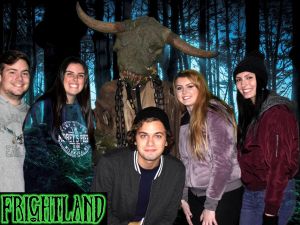John Carpenter’s “Halloween” is celebrating its 40th anniversary this year. To this day, it remains a popular horror film among audiences. Even though there is no happy ending and it ends as a cliffhanger, people still choose to watch it. When asked why they would pay money to scare themselves, many say that it is fun.

Margee Kerr, an adjunct professor of sociology at the University of Pittsburgh, always found that answer very unsatisfying. Because of this, she teamed up with her colleague, cognitive neuroscientist Dr. Greg Siegle, and they spent two years gathering data in the basement of an extreme haunted attraction outside Pittsburgh called Scarehouse.
Scarehouse contains a variety of unsettling situations that go beyond intimidating characters and special effects. Those who attended would be touched by the actors, restrained and exposed to electricity.
For this study, Kerr and Dr. Siegle recruited 262 people who had already purchased tickets for the adult-only attraction. Before the guests entered, the duo had them fill out a survey asking them how they were feeling at the moment. When the subjects got out, they were asked to answer questions on how they were feeling afterwards. Kerr and Dr. Siegle even used EEG technology to measure brain activity of 100 participants as they went through a series of emotional attacks before and after the attraction.
Results of the final surveys showed that those who went through the attraction came out feeling much better and less anxious. Analysis of the EEG data also indicated that after going through the attraction, brain activity ceased which in turn is associated with feeling better. In addition, Kerr claimed that going through scary attractions in a contained environment can serve as a way to “practice being scared and build greater self-knowledge and resilience.”
Basically, going through a haunted attraction gave these people a sense of accomplishment, as if they were climbing a rock wall or running a 5k.
Assistant professor of psychology at Cabrini University Dr. Ruta Clair claims that when people are scared, their body goes into a flight-or-fight response and an adrenaline rush. Because the brain works in pathways, those pathways release adrenaline when people are scared, and some people interpret that feeling as fun.
“It’s the same reason why some people like roller coasters and some people don’t,” Clair said.

Clair also believes that the reason people say that they find getting scared fun is because they do not understand what is happening to them, thus, they can’t describe the feeling. They think of it as fun, most likely because of how their body relaxes after the adrenaline rush they feel.
Clair pointed out that there is a theory explaing that when we are under stress, it triggers a release of hormones that are tied to social connections and we seek social connection when we are stressed. This is also because of the brain pathways that go off and release hormones when we are scared or stressed.
“If you need social support when you are feeling stressed, when you’re coming off a roller coaster or a social experience, it’s the same kind of process,” Clair said.
In addition, Clair concured that going through haunted attractions or watching horror films can help build resilience and learn more about themselves. She claims that people with anxiety should be exposed to anxiety inducing situations that are safe and controlled. As a result, it can allow people to understand themselves and gain confidence that they can get through it.
Clair agreed with Kerr’s claim that going through haunted attractions can lead to someone feeling a sense of accomplishment, claiming that there are two systems going on in the brain: the sympathetic system and the para-sympathetic system. The sympathetic system is what is what works people up, whereas the para-sympathetic system is the calming system which calms them down after the experience.
“When people have that calming experience, it feels good and it is sort of relaxing,” Clair said.
Sophomore exercise science major Brooke Palmer is a fan of horror films but is a bigger fan of going to haunted attractions around Halloween. She prefers haunted attractions because they allow her to completely immerse herself in the current setting and she enjoys the adrenaline rush.
“Sitting down and just watching a movie is one thing, but it’s so different to feel like you’re experiencing those things first-hand,” Palmer said. “You’re facing your fears straight on.”

Palmer prefers to go to haunted attractions with friends because she is terrified to go alone and has a lot of fun doing it with friends. On the weekend of Oct. 13-14, she went to a haunted attraction in Delaware called Frightland and had a blast.
“I actually enjoy it so much because it gives me such an adrenaline rush,” Palmer said. “I love to prepare myself for the unexpected, but know that I’ll be scared.”
Palmer claims that she feels a sense of accomplishment when she gets through attractions because she feels that she conquers her fears every time.
Junior education studies major Polly Post is also a fan of haunted attractions and prefers going with friends. Post prefers going with friends through a haunted attraction because she has control of how fast it goes whereas with a movie, she has to wait for it to end. Despite fearing what will happen, Post enjoys going to haunted attractions and feels a sense of accomplishment when she’s finished.
“I enjoy screaming and letting loose and just letting myself be scared,” Post said.
Junior education major Kaelyn Hassey is a big fan of going to haunted houses, her favorite being Eastern State Penitentiary, and claiming that watching scary movies is so much fun. Hassey also prefers partaking in such activities with friends and gets a sense of accomplishment when she gets through them.
“I think it’s so thrilling,” Hassey said. “It really puts me in the fall spirit. It’s a great time of the year.”
It appears that the real reason people get a sense of enjoyment after being scared is because of the calming affect they feel after the initial adrenaline rush. As a result, they feel a sense of accomplishment and that they overcame their fears if the environment they were in was controlled.
“It could be part of something you do to overcome something in a safe setting,” Clair said.



